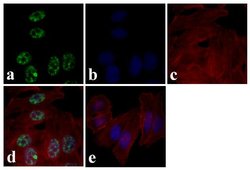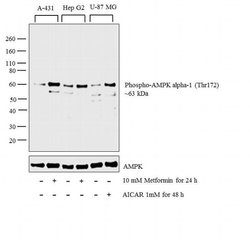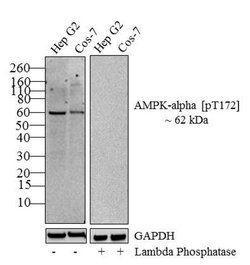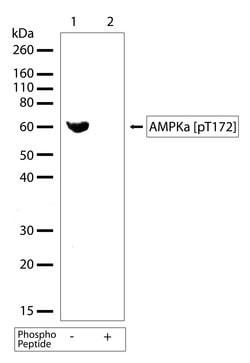Learn More
Invitrogen™ Phospho-AMPK alpha-1,2 (Thr183, Thr172) Recombinant Superclonal™ Antibody (10HCLC)
Rabbit Recombinant Superclonal Antibody
Supplier: Invitrogen™ 710099
Description
This antibody is predicted to react with mouse, rat, non-human primate and Drosophila based on sequence homology. Recombinant rabbit Superclonal™ antibodies are unique offerings from Thermo Fisher Scientific. They are comprised of a selection of multiple different recombinant monoclonal antibodies, providing the best of both worlds - the sensitivity of polyclonal antibodies with the specificity of monoclonal antibodies - all delivered with the consistency only found in a recombinant antibody. While functionally the same as a polyclonal antibody - recognizing multiple epitope sites on the target and producing higher detection sensitivity for low abundance targets - a recombinant rabbit Superclonal™ antibody has a known mixture of light and heavy chains. The exact population can be produced in every lot, circumventing the biological variability typically associated with polyclonal antibody production. Note: Formerly called Recombinant polyclonal antibody, this product is now rebranded as Recombinant Superclonal™ antibody. The physical product and the performance remain unchanged.
The protein encoded by this gene is a catalytic subunit of the AMP-activated protein kinase (AMPK). AMPK is a heterotrimer consisting of an alpha catalytic subunit, and non-catalytic beta and gamma subunits. AMPK is an important energy-sensing enzyme that monitors cellular energy status. In response to cellular metabolic stresses, AMPK is activated, and thus phosphorylates and inactivates acetyl-CoA carboxylase (ACC) and beta-hydroxy beta-methylglutaryl-CoA reductase (HMGCR), key enzymes involved in regulating de novo biosynthesis of fatty acid and cholesterol. Studies of the mouse counterpart suggest that this catalytic subunit may control whole-body insulin sensitivity and is necessary for maintaining myocardial energy homeostasis during ischemia.
Specifications
| Phospho-AMPK alpha-1,2 (Thr183, Thr172) | |
| Recombinant Superclonal | |
| 0.5 mg/mL | |
| PBS with 0.09% sodium azide | |
| P54646, Q13131 | |
| PRKAA1, PRKAA2 | |
| Peptide corresponding to amino acids 168-178 of human AMPK alpha. | |
| 100 μg | |
| Primary | |
| Human, Monkey | |
| Antibody | |
| IgG |
| Western Blot, Immunocytochemistry | |
| 10HCLC | |
| Unconjugated | |
| PRKAA1 | |
| 2310008I11Rik; 5'-AMP-activated protein kinase alpha-1 catalytic subunit; 5'-AMP-activated protein kinase alpha-2 catalytic subunit; 5'-AMP-activated protein kinase catalytic alpha-2 subunit; 5'-AMP-activated protein kinase catalytic subunit alpha-1; 5'-AMP-activated protein kinase catalytic subunit alpha-2; 5'-AMP-activated protein kinase, catalytic alpha-1 chain; 5'-AMP-activated protein kinase, catalytic alpha-2 chain; 63 kDa subunit; A830082D05; AAPK2; ACACA kinase; acetyl-CoA carboxylase kinase; AI194361; AI450832; AL024255; AMP -activate kinase alpha 1 subunit; AMP-activated protein kinase; AMP-activated protein kinase alpha 2; AMP-activated protein kinase alpha-2 subunit variant 2; AMP-activated protein kinase alpha-2 subunit variant 3; AMP-activated protein kinase alpha-2 variant B; AMP-activated protein kinase, alpha 1 catalytic subunit; AMP-activated protein kinase, catalytic, alpha-1; AMPK; AMPK 63 kDa subunit; AMPK alpha 1; AMPK alpha 2; AMPK alpha-1 chain; AMPK alpha-2 chain; AMPK subunit alpha-1; AMPK subunit alpha-2; AMPK1; AMPK2; AMPKa1; AMPKa2; AMPK-activated protein kinase alpha-2 subunit; AMPKalpha1; AMPK-alpha-1 chain; AMPKalpha2; AMPK-alpha-2 chain; C130083N04Rik; HMGCR kinase; hydroxymethylglutaryl-CoA reductase kinase; pAMPK; PRKAA; Prkaa1; Prkaa2; protein kinase; protein kinase AMP-activated alpha 2 catalytic subunit; protein kinase AMP-activated catalytic subunit alpha 1; protein kinase AMP-activated catalytic subunit alpha 2; protein kinase, AMP-activated, alpha 1 catalytic subunit; protein kinase, AMP-activated, alpha 2 catalytic subunit; tau-protein kinase PRKAA1 | |
| Rabbit | |
| Protein A | |
| RUO | |
| 5562, 5563 | |
| Store at 4°C short term. For long term storage, store at -20°C, avoiding freeze/thaw cycles. | |
| Liquid |
Safety and Handling
Your input is important to us. Please complete this form to provide feedback related to the content on this product.



